|
ACRYLIC
Acrylic paint is considered one of the easiest painting media to use, partially due to their make up. Acrylics are water-based, which means not only can they be used at various densities simply by diluting with water, they can also be cleaned up with water, making them relatively risk-free as far as your hands, carpet, and surrounding fabrics are concerned.
Another quality of acrylic which is sometimes beneficial is their drying time. Acrylics dry very quickly, which allows the artist to layer colors in a short period of time without the colors mixing on the canvas, and shortens the wait time between finishing the piece and display. This is not always an advantage, however, since some artists want to create new tones and shades on the canvas. There are additives that keep the paint wet for longer, but they take some experimentation; adding too much can result in a permanently tacky surface.
A wide range of substances and materials can be added to acrylic paint to alter its effect. Sand or rice mixed in create interesting textures, and acrylic gels allows the paint to maintain peaks on the surface of the canvas for dimension.
Once it has been treated with a primer such as gesso (see below), virtually any surface can be painted with acrylics, from plastic to fabric.
Many famous modern artists used acrylic paint in their work, including Andy Warhol, Mark Rothko, Jackson Pollock, and Roy Lichtenstein.
BLACKLIGHT PAINT
Also called luminous or fluorescent paint, this media is formulated to reflect the ultraviolet wavelengths emitted by blacklights - those dim bulbs that radiate a soft blue light and are often found in nightclubs, amusement parks, and other entertainment locales.
Blacklight paint is often used as body paint at festivals, but gallery shows utilizing blacklights are becoming quite popular. Blacklight painted images will show up in regular light, but will appear to glow when exposed to the ultraviolet rays. In some cases, the colored pigments mixed with the UV-reactive paint will make the image appear "brighter" than regular paint in the visible light spectrum. This quality makes blacklight paint suitable for viewing in both regular and UV light.
Austrian artist Bogi Fabian creates "glowing murals" that look stunning in both visible and blacklight.
CASEIN
Derived from milk casein (milk protein), casein paint is water soluble and has the texture and consistency of glue. Much like acrylic paint, it can be thinned using water for different applications and end results. When dry, casein paint is very stiff and brittle, so while it can be applied to almost any surface, flexible substrates such as paper and canvas are not recommended.
Casein is often used as a base coat, or for "underpainting." It dries with a smooth, matte finish and is though to resemble oil paint more than other water-based media. It can be buffed to produce a velvety finish, or varnished for a shiny effect. Over time, casein paint becomes water resistant.
Commercial illustrators used casein paint almost exclusively until the 1960s, when acrylics became popular. Native American artist Oscar Howe often used casein paint, and some of Andy Warhol's early paintings were done in this media as well.
CRAFT PAINT
Basic craft paint is most often inexpensive acrylic paint. It comes in a wide range of colors, as well as different textures. Metallic and glitter-infused craft paints are available, as well as finishes like satin, chalk, and gloss. Craft paints are generally easy to clean up, and can be applied to many surfaces, from wood and paper to canvas, fabric, and plastic.
ENCAUSTIC
Encaustic paints are created using wax colored with pigments, which is heated and applied to an absorbent surface - often wood though canvas can be used as well. Metal tools or brushes are used to apply the hot wax paint to the surface. Once the painting is complete, the whole thing is heated again in order to fuse the paint to the surface.
Because wax is water-repellant, encaustic paintings do not need to be varnished or otherwise protected. By buffing the finished surface, the colors can be further saturated for a lustrous appearance. The paint will not discolor over time.
Encaustic has been used since at least the 1st century C.E., notably in the Fayum mummy portraits from Egypt. Jasper Johns and Diego Rivera occasionally used encaustic, ass well as contemporary artists Betsy Eby, Tony Scherman, and Jenny Sages.
FABRIC PAINT
Fabric paint is intended specifically for use on textiles, and is therefore formulated to produce the best results on this surface. Different types of fabric paint exist, including those that dye the fabric when applied, and those that remain on the surface.
Fabric paints are known to work best on natural fabrics like cotton, linen, and silk. Depending on the type, they may or may not be able to hold up to multiple washes. Paints come in tubes, pots, or as sprays, and fabric markers and crayons are also available. Often, stencils are placed on the fabric and the paint is applied within the lines of the shape.
FRESCO
More of a painting style than a specific media, fresco is a mural painting technique that uses "buon fresco" pigments mixed with water. The paint is applied to a surface of wet lime plaster. By applying the paint before the plaster has dried, the paint is absorbed and becomes a part of the wall itself.
Commonly associated with the Italian Renaissance, parts of Michelangelo's Sistine Chapel, as well as the large mural "School of Athens" by Raphael are frescos. Both these artists scraped out the still-wet plaster from certain areas to give depth and dimension to the painting. Michelangelo was known for "outlining" his main figures in this way.
GESSO
Made from mixing an animal glue binder with chalk or pigment, gesso (also called "glue gesso" or "Italian gesso) is a thick, absorbent substance, generally white, used to prepare canvas and other surfaces for colored paints. Due to its absorbency, gesso is a suitable base for all paints - water-based acrylics, oil paints, or temperas. Ideally, gesso used for this purpose is carefully applied to a rigid surface in as many as ten or more very thin layers.
Another type of gesso is "acrylic gesso," and can be used as a primer for both oil and acrylic paints (while traditional gesso is suitable only for oil paint). Technically a different product altogether acrylic gesso is a combination of calcium carbonate and a polymer latex, pigments, and chemicals that maintain a flexibility not found in traditional gesso. This allows the paint to be applied to non-rigid surfaces such as canvas.
It can be mixed with pigments to create different colors, and many canvases on the market already have this gesso applied, so the canvas is ready to paint. Though oil paint can be applied to the surface, the differences in flexibility between the media can cause delamination in the oil paint.
GLASS PAINT
Glass and porcelain paints are often transparent, allowing light to pass through them while still retaining their color. They generally need to be non-toxic, since they may be used on glassware or dishes, as well as dishwasher-safe and heat-resistant. They come in a wide variety of colors and may be applied as a spray, with a nozzle tip, or brushes.
Some paints require "heat setting" or curing, which usually involves placing the finished piece in a hot oven for a set amount of time, during which the paints will fuse to the surface of the glass or ceramic.
GLAZE
Like gesso, glazes are used in concordance with other paints. Depending on their formulation, glazes may alter the transparency, colorfulness, or actual color of the paint, and may either be mixed into the media prior to application, or added as a topcoat once the painting is finished.
In oil painting, an oily, transparent layer of glaze may be applied over a partially dried canvas. Because light passes through the glaze and is reflected off the opaque surface of the paint, a kind of glowing effect is achieved. Alternately, layers of paint mixed with glaze can appear to blend together despite having been allowed to dry completely between applications.
It is believed the "smoky," almost fuzzy quality of the Mona Lisa by Leonardo da Vinci was created by overlaying dozens of thin layers of glaze in the slightest variations of color. Because glazes take a very long time to dry, this effect probably took years to complete.
GOUACHE
Gouache is made by mixing pigments with gum arabic (a binder) and water. Though this is the same binder used in watercolor paint, the ratio of pigment to water is higher, making gouache a much thicker media. Sometimes white chalk pigment is also used, which results in a more opaque and reflective finish. The paint generally looks different dry than wet, with dark colors appearing lighter, and vice versa.
Famous painters such as George Inness, Paul Klee, Winslow Homer, and Edward Hopper were known to paint with gouache.
KIDS PAINT
Paint made especially for use by children may be called poster paint, tempera, or finger paint. It is always non-toxic, and washes off easily with water. They often come in wide-mouthed pots that allow for brushes or fingers to be inserted directly into the container. Some kinds are a hard palate to which water is applied to release the color. This type of paint - essentially watercolors - minimizes mess by being spill-proof.
Color brands like Crayola offer a wide range of paints for children.
MAGNA PAINT
Magna paint was developed in 1947 and is no longer available today. Though technically an acrylic resin paint, magna differed greatly from traditional acrylic paints. It was made by grounding pigments into acrylic resin, and emulsifying the mixture with solvents. As a result of this manufacturing process, magna was glossier when dry than many paints available today and was not water soluble.
Roy Lichtenstein used magna paint to create his unique "comic book" Pop Art pieces. Abstract expressionists Barnett Newman, and Morris Louis also used this media in their works.
OIL
One of the best known painting media, oil is a slow-drying paint made from pigments mixed with oil - generally linseed. Solvents such as turpentine can be added to alter the viscosity of the paint, and varnish is often applied on top of the artwork to increase glossiness. Oil paints as an artistic medium became popular in the 15th century, and shortly after they surpassed tempera as the most used media.
Oil paints require a "drying oil" that will eventually harden (unlike some oils). Such oils require a high level of polyunsaturated fatty acids. Unlike water-based paints, oil paints do not dry due to evaporation, but rather because of "polymerization," which transforms them into a dry semisolid. Because this type of "drying" takes longer than acrylics or other water-based paint, the artist can develop and revise paintings slowly and deliberately, often with months available for alteration.
Because they blend together well, oil paints can easily create subtle color variations, and light or shadow details. Some artists particularly adept at working in this challenging media include Claude Monet, Johannes Vermeer, Leonardo da Vinci, and Vincent van Gogh.
PRIMER
As its name implies, a primer is often the first layer of the surface to be painted, applied in order to "prime" or prepare it for the application of colored paint. Though many different primers are used for painting floors, walls, or other surfaces in home renovation, in art the term is essentially interchangeable with the term "gesso," and most often refers to acrylic gesso since it is more versatile than traditional gesso.
INK WASH
While inks are usually thought of in connection to drawing, not painting, they can also be used to paint. Ink Wash Painting (Sumi-e in Japanese) is an East Asian technique that applies black ink to paper using brushes. Shading is achieved by varying the density of the ink by either adding water or using less ink on the brush.
A very involved painting style, sumi-e artists spend years learning to handle the brush and ink in order to produce paintings with huge tonal differences, despite the use of a single pot of ink. One brush stroke can itself create a variety of shades.
The artists of the Chinese "Southern School", as well as the Four Masters of the Ming Dynasty worked in the Ink Wash painting style. Contemporary artists Qin Feng and Liu Qinghe use variations of the technique in their work.
TEMPERA
Also known as "egg tempera," this media is fast-drying and water soluble, consisting of colored pigments mixed with a gel-like substance such as egg yolk. Recognized for lasting a very long time, there are tempera paintings from the first century C.E. that are still in good condition. This media was used by most artists until the 1500s, when oil painting became popular.
Today, tempera is often called "poster paint," and is an inexpensive media often used for children's paintings because it is generally non-toxic and easy to clean. It is no longer made with egg yolk, but a different glue-like compound.
William Blake and the artists of the Pre-Raphaelite painting movement used tempera again in the 18th and 19th centuries, and some modern and contemporary artists have made it their media of choice, including Alex Colville and Philip Aziz.
WATERCOLOR
Watercolor paints are made by mixing powdered pigment with a water-soluble carrier. Because these paints are little more than carrier and powder, the colors tend to appear very luminous - no fillers impair the final hues. Watercolor paint is usually used on a thick, textured paper widely known as "watercolor paper", though papyrus, vinyl, fabric, and canvas can be used as well.
Due to their high water content, watercolor paints immediately stain the paper when applied. For this reason, they are nearly impossible to completely cover with another color, or remove from the surface, unlike acrylics. Also due to their translucency and thinness, a white color paint is not made. Parts of a watercolor picture that are required to be white are generally left unpainted.
Many watercolor artists also use watercolor pencils or pastels. Though they look like pencil crayons or regular pastel chalks, these water-soluble colors can be used to draw fine details on paper. Water is then added to blend the colors. Other techniques used include "wet in wet", and "drybrush."
Famous watercolor artists include Albrecht Durer, Georgia O'Keeffe, and J.M.W. Turner.
|
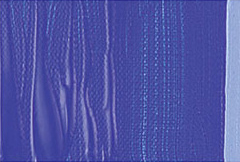
Acrylic paint

Acrylic: artist unknown

Encaustic: Fayum Mummy Portrait, 2nd C
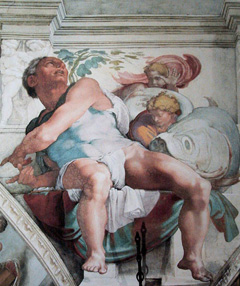
Fresco: Sistine Chapel, Michelangelo, 1470
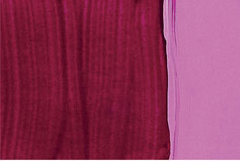
Gouache paint
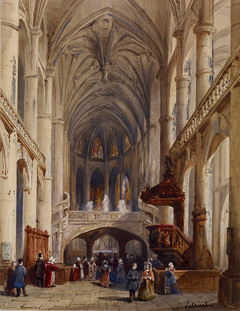
Gouache: Charles Louis Lesaint, 19th C
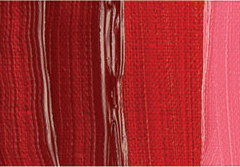
Oil paint

Oil: Monet, 1906
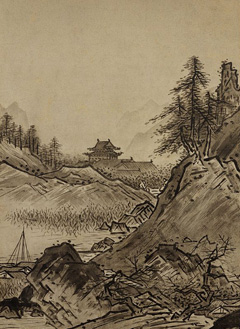
Ink Wash: Sesshu Toyo, 15th C

Tempera: Duccio, 13th C

Watercolor paint

Watercolor: Winslow Homer, 1892
|

